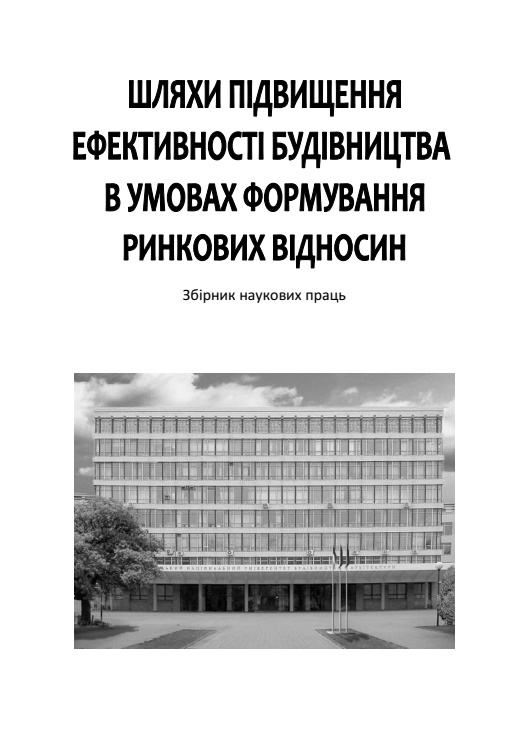Rrestoration (Repair) Methods of the Lower Surfaces of Reinforced Concrete Structures by Forming a Mixture into a Formwork
DOI:
https://doi.org/10.32347/2707-501x.2021.48(1).90-99Keywords:
repair, restoration, formwork, reinforced concrete structure, repair mixtureAbstract
The article presents technological solutions that can be used to restore and strengthen significant areas of the lower surfaces of span reinforced concrete structures, as well as minor deep damage of the lower surface of reinforced concrete structures. This method is used to repair fragmentary damage of the lower surfaces of structures. The presented methods consist in preparation of the base, arrangement of the formwork, and feeding repair mixture into the shuttering through the holes in the structure or in the shuttering.
The method of restoring large surfaces consists in feeding a high-mobility non-shrinkable concrete mixture into the gap between the restored structure and the previously arranged formwork. After preparing the base, at the highest points of the damaged structure through-holes are drilled to supply the concrete mixture, release air and control the filling of the cavity with the mixture. The fixed formwork panels must completely cover the restored part of the structure and partially extend onto the undamaged surface of the structure. The prepared concrete mixture is fed through a funnel into the hole until the cavity and holes are completely filled up with it and vibrate. After a day, the formwork is removed and moistened for 3 days.
To repair minor deep damage to the lower surfaces of reinforced concrete structures is performed by feeding a highly mobile non-shrinkable mixture into the space between the structure and pre-mounted formwork is performed using a syringe for soluble mixtures. Holes are drilled in the formwork to release air and supply the mortar. Flexible tubes are installed in the holes. A syringe with the prepared solution is connected to the rubber tube and filled the cavity. After the mixture begins to come out through the air release tube, it is removed, and a plug is installed in the hole. When the cavity of the damaged fragment is completely filled, the rubber hose is bent and fixed in this position, and the syringe for the solution is disconnected. After 5 hours, the restored fragment is stripped and looked after.
The proposed methods make it possible to carry out high-quality repair work on the lower surfaces of spans without using special complex equipment, which reduces the cost of repair work.
References
Бубенщикова Е.С. Влияние различных агрессивных факторов на состояние арматуры железобетонных изделий. Молодой ученый. 2020. № 17. С. 36–38.
Галушко В. А. Технологические основи инновации при ремонте и восстановлении зданий: дис. … д-ра техн. наук: 05.23.08. Одесса, 2013.
ДСТУ Б В.3.1-2:2016. Ремонт і підсилення несучих і огороджувальних будівельних конструкцій та основ будівель і споруд. На заміну ДБН В.3.1-1-2002; чинний від 2017-04-01. Вид. офіц. Київ: ДП «УкрНДНЦ», 2017. 72 с.
Карапузов Є. К. Система матеріалів для ремонту та захисту бетону. Будівельні матеріали і вироби: всеукраїнський науково-технічний виробничий журнал. К.: ДП НДІБМВ, 2012. Т 1, № 72. С. 34 – 37.
Молодід О. С., Шарикіна Н. В. Експериментальні дослідження технології відновлення нижньої поверхні залізобетонних конструкцій з використанням опалубки. Шляхи підвищення ефективності в будівництві в умовах формування ринкових відносин, 2018. № 35. С. 173 – 181
Молодід О. С., Шарикіна Н. В. Технологічні чинники, які впливають на експлуатаційні показники відновлених залізобетонних конструкцій. Шляхи підвищення ефективності будівництва в умовах формування ринкових відносин. 2019. № 41. С. 3–11.
Савицкий А. Н., Пшинько А. Н., Савицкий Н. В. Технология ремонта железобетонных конструкций высокоподвижными ремонтными смесями. Строительство. Материаловедение. Машиностроение. Серия: Инновационные технологии жизненного цикла объектов жилищно гражданского, промышленного и транспортного назначения. 2006. № 37. С. 431–437.
EN 1504 Product and system for the protection and repair of concrete structures – Defines the general principles for the use of products and systems, for the repair and protection of concrete – Was approved by CEN on 2 June 2005. 214 р.
Galinsky O.M., Molodid O.S., Sharikina N.V. and Plokhuta R.O. Research of technologies for restoration of the concrete protective layer of reinforced concrete constructions during the reconstruction of the buildings and structures. IOP Conference Series: Materials Science and Engineering, Volume 907, Innovative Technology in Architecture and Design (ITAD 2020) 21–22 May 2020, Kharkiv, Ukraine. 7 р. doi:10.1088/1757-899X/907/1/012056
Ruili He. (2014). Rapid repair of severely damaged RC columns under combined loading of flexure, shear, and torsion with externally bonded CFRP: PhD Thesis. 333р.
Downloads
Published
How to Cite
Issue
Section
License

This work is licensed under a Creative Commons Attribution 4.0 International License.
Authors who publish with this journal agree to the following terms:
- Authors retain copyright and grant the journal right of first publication with the work simultaneously licensed under a Creative Commons Attribution License that allows others to share the work with an acknowledgement of the work's authorship and initial publication in this journal.
- Authors are able to enter into separate, additional contractual arrangements for the non-exclusive distribution of the journal's published version of the work (e.g., post it to an institutional repository or publish it in a book), with an acknowledgement of its initial publication in this journal.
- Authors are permitted and encouraged to post their work online (e.g., in institutional repositories or on their website) prior to and during the submission process, as it can lead to productive exchanges, as well as earlier and greater citation of published work (See The Effect of Open Access).

